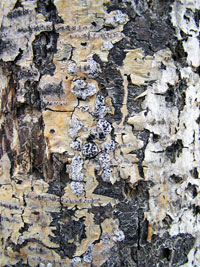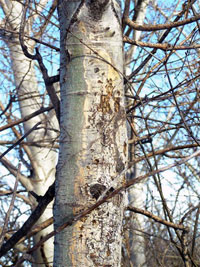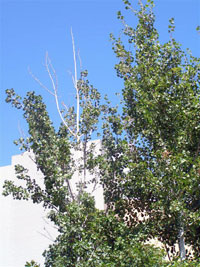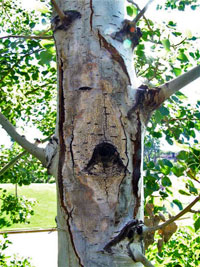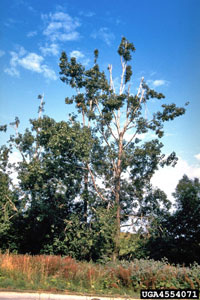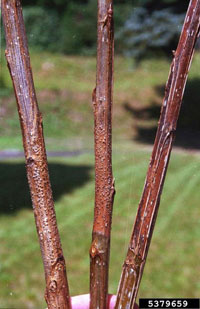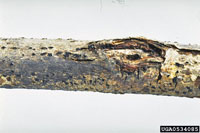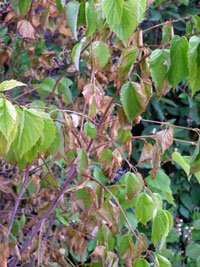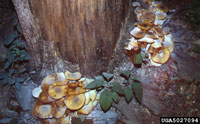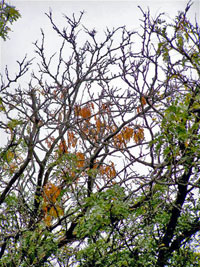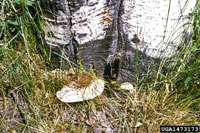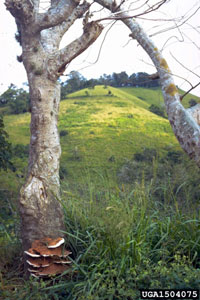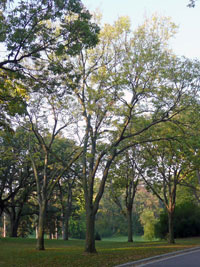Extension > Garden > Diagnose a problem > What's wrong with my plant? > Deciduous Trees > Poplar > Leaves wilt, then turn yellow or brown
Poplar > Leaves > Leaves wilt, then turn yellow or brown
1 of 6
Hypoxylon canker
Entoleuca mammata
- Leaves on one or more branches are undersized, turn yellow then to brown and remain attached to stem
- Cankers begin near wounds or at the base of a branch
- Infected bark initially turns yellowish-orange; older infections are black at center with yellowish-orange margins
- Bark first appears blistered and raised, then falls off to reveal blackened wood
- Clusters of raised buff white to black bump like fungal stromata can be seen on 3 year old cankers
- Damage most common on trembling aspen
- More information on Hypoxylon canker
2 of 6
Valsa and Leucostoma cankers
Valsa sordida and Leucostoma niveum
- Leaves on random branches wilt, turn yellow then brown
- Random dead branches seen throughout canopy
- Sunken irregularly-elongated cankers with cracked bark at the edges occur on branches or the main trunk
- Cankers are brown to black at the center with salmon to orange discoloration of the bark at the edges
- In wet weather curled tendrils of orange spores emerge from pimple like fungal structures within infected branches
- Common on trees stressed by drought, winter injury, wounds, insect feeding or other factors
- More information on canker
3 of 6
Cryptodiaporthe canker
Cryptodiaporthe populea
- Leaves on infected branches turn yellow and drop prematurely
- Random dead branches caused from girdling cankers seen throughout canopy
- Bark on cankers may or may not be discolored, but the tissue beneath the bark will be brown to black
- Multiple thin weak adventitious shoots develop
- Callus tissue formed around edges of cankers causing bark to fall off and expose the wood beneath it
- Common on Lombardy poplars
4 of 6
Armillaria root rot
Armillaria spp.
- Infected trees have poor growth, dead branches in the upper canopy, undersized and/or yellow leaves
- Flat white sheets of fungal growth (mycelia fans) grow between the bark and sapwood at the base of infected trees
- Thick black, shoestring-like fungus can sometimes be seen under the bark, around roots and in the soil around the base of the tree
- Wood is decayed, white, soft and spongy, and this may extend from the base of the tree well up into the trunk
- Clusters of honey-colored mushrooms may grow at the base of the tree in fall
- More information on Armillaria root rot
5 of 6
Ganoderma root and butt rot
(aka. artist's conk)
Ganoderma applanatum
- Leaves are smaller in size and turn yellow earlier than normal
- Canopy appears thin with few leaves and multiple dead branches
- Fungal conks, a semicircle shelf fungi, can be found from the base of the tree up to 3 feet high on the trunk
- Conks are reddish brown and shiny on top, white and porous underneath, a rim of white may be visible on the edge of
growing conks - Infected wood at tree base is white, soft, stringy or spongy
- Infected trees frequently break or fall over in storms
- More information on Ganoderma butt rot
6 of 6
Drought
- Dried brown to gray-green leaves hang on the tree or foliage drops unseasonably and litters the ground under the tree
- Foliage sometimes turn brown around the edges but more commonly turns a dull, gray-green color
- Severe drought stress may cause dieback of individual branches starting at branch tips
- More information on watering trees and shrubs




